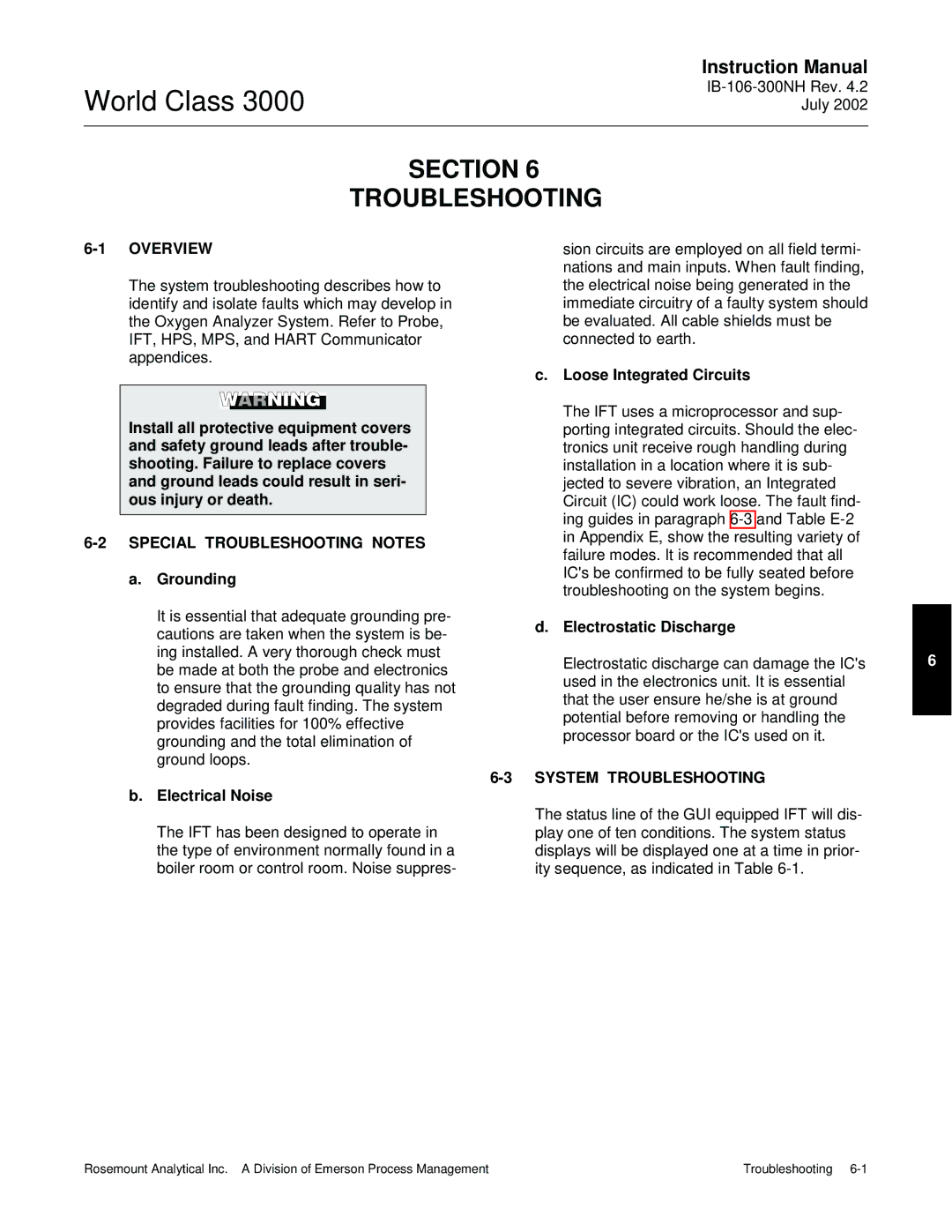
World Class 3000
Instruction Manual
SECTION 6
TROUBLESHOOTING
|
| sion circuits are employed on all field termi- |
| ||||||||
|
|
|
|
|
|
|
|
|
| nations and main inputs. When fault finding, |
|
| The system troubleshooting describes how to |
| the electrical noise being generated in the |
| |||||||
| identify and isolate faults which may develop in |
| immediate circuitry of a faulty system should |
| |||||||
| the Oxygen Analyzer System. Refer to Probe, |
| be evaluated. All cable shields must be |
| |||||||
| IFT, HPS, MPS, and HART Communicator |
| connected to earth. |
| |||||||
| appendices. | c. | Loose Integrated Circuits |
| |||||||
|
|
|
|
|
|
|
|
|
| ||
|
|
|
|
|
|
|
|
|
| The IFT uses a microprocessor and sup- |
|
|
|
|
|
|
|
|
|
|
|
| |
| Install all protective equipment covers |
|
|
| |||||||
|
|
| porting integrated circuits. Should the elec- |
| |||||||
| and safety ground leads after trouble- |
|
| tronics unit receive rough handling during |
| ||||||
| shooting. Failure to replace covers |
|
| installation in a location where it is sub- |
| ||||||
| and ground leads could result in seri- |
|
| jected to severe vibration, an Integrated |
| ||||||
| ous injury or death. |
|
| Circuit (IC) could work loose. The fault find- |
| ||||||
|
|
|
|
|
|
|
|
|
| ing guides in paragraph |
|
|
| in Appendix E, show the resulting variety of |
| ||||||||
| failure modes. It is recommended that all |
| |||||||||
|
|
|
|
|
|
|
|
|
|
| |
| a. | Grounding |
| IC's be confirmed to be fully seated before |
| ||||||
|
| troubleshooting on the system begins. |
| ||||||||
|
|
|
|
|
|
|
|
|
|
| |
|
| It is essential that adequate grounding pre- | d. | Electrostatic Discharge |
| ||||||
|
|
| |||||||||
|
| cautions are taken when the system is be- |
| ||||||||
|
| ing installed. A very thorough check must |
| Electrostatic discharge can damage the IC's | 6 | ||||||
|
| be made at both the probe and electronics |
| ||||||||
|
|
| used in the electronics unit. It is essential |
| |||||||
|
| to ensure that the grounding quality has not |
|
| |||||||
|
|
| that the user ensure he/she is at ground |
| |||||||
|
| degraded during fault finding. The system |
|
| |||||||
|
|
| potential before removing or handling the |
| |||||||
|
| provides facilities for 100% effective |
|
| |||||||
|
|
| processor board or the IC's used on it. |
| |||||||
|
| grounding and the total elimination of |
|
| |||||||
|
| ground loops. |
|
|
| ||||||
|
| SYSTEM TROUBLESHOOTING |
| ||||||||
| b. | Electrical Noise |
|
|
| ||||||
The IFT has been designed to operate in the type of environment normally found in a boiler room or control room. Noise suppres-
The status line of the GUI equipped IFT will dis- play one of ten conditions. The system status displays will be displayed one at a time in prior- ity sequence, as indicated in Table
Rosemount Analytical Inc. A Division of Emerson Process Management | Troubleshooting |
